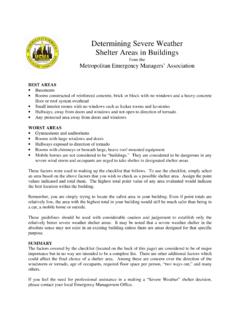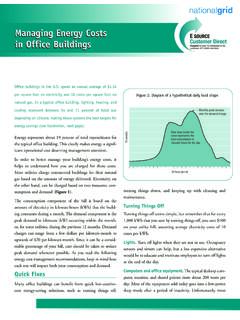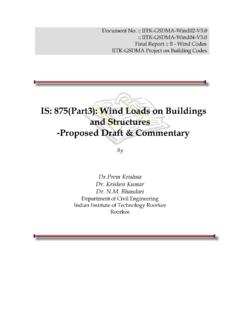Transcription of Shaping Buildings for the Humid Tropics - Green Home …
1 1 Shaping Buildings for the Humid Tropics Shaping Buildings for the Humid Tropics : Cultures, Climate, and Materials Patti Stouter, ASLA. First edition, November, 2008. Online version available at Please share these self-help guidelines and let us know how to improve them. 2 Shaping Buildings for the Humid Tropics TABLE OF CONTENTS: 3 Introduction 4 Buildings FOR PEOPLE. 6 PLANNING FOR COMFORT: 6 Ventilation 7 Shading 9 Plantings 10 Insulation 10 DESIGN WITH NATURE: 12 Plants 13 Water and Soil 15 LIGHTWEIGHT building MATERIALS. 18 COMPARING TYPES OF MASONRY. 20 building WITH MASONRY. 24 Acknowledgments 25 The Author 26 Bibliography 28 Photo Credits 3 Shaping Buildings for the Humid Tropics Introduction Buildings for hot- Humid climates should be comfortable in heat and dampness. The humidity is usually above 60% and often nearly 100% in many regions. Simple, low-cost Buildings can be cool, dry, and mold-free if they are carefully planned. Buildings in other areas have conquered cold and dangers like earthquakes.
2 These same new Buildings are often uncomfortable and overpriced in the Tropics . Large areas in the Tropics , like much of central Africa and central South America, are free from serious earthquakes or tsunamis. People in the Tropics have to conquer torrential rains and termites. They shouldn't throw money away building for a hazard that they don't have. People also live differently in the Tropics than in colder regions, and differently than they did 100 years ago. Old traditional Buildings don't fit the way they live now, because cultures have changed. New Buildings should fit the ways people live in the Tropics . This booklet and its sequels, Earthbag building in the Humid Tropics and Simple Earth Buildings for the Humid Tropics have some guidelines that can help you plan smarter for your beautiful and challenging part of the world. A thatch and earthbag performance building in South Africa. 4 Shaping Buildings for the Humid Tropics Buildings For People Old Buildings responded to the weather, the economy, and the people.
3 The relationships and work patterns of the people lasted longer than their Buildings . The process of making Buildings taught young people how to behave and to understand their world. It was a basic personal skill, so houses seemed like a part of their own bodies. Much has changed, and old shapes may no longer work with how people live today. People move, get different jobs, but expect houses to last. People spend much more time inside, need more room for belongings, and may need to lock up their houses. Right: A modern apartment building in Cameroon. How do people use Buildings ? In many city areas people still spend a lot of time outside and want porches or pavilions that shade and shelter them from rain. But they also want a good wall or fence to keep them safe. Many people outside of the biggest cities still prefer to cook over wood fires. This is not just because they lack a 'better stove.' Wood may be cheaper, or free. In some places small fires burn inside to give light and to keep the mosquitoes out and preserve roof rafters and thatch.
4 Separate wash and cooking Buildings are often used to keep moisture and heat out of the main building . Showers, laundry areas, and kitchens can be located where breezes will blow extra moisture and heat away, or can be separated by breezeways. Locating them within the same walls may be less costly, but they could have outside access or be separated from the rest of the building . Above left: An outdoor workshop for a craftsman. Above right: Selling and visiting outdoors. 5 Shaping Buildings for the Humid Tropics Buildings also have meanings. The only way to find out what they are is to ask the locals. Show them photos of traditional building details or styles. Ask what they think of them, and how these kinds of Buildings make them feel. Above left: Roofs of the powerful In northwest Cameroon. Above right: An Arabic arch motif for religion or ethnicity? Below right: A doorway at the mosque in Djenne, Mali. Among some people pinnacles or buttresses added to courtyard walls symbolize protection because they look like the ancient shrines called 'pillars of the dead' and the pinnacled mosques.
5 1. These sloping pier shapes could be easily used in a new building . Many peoples had round Buildings until concrete block made them too difficult to build. To some round Buildings may feel more like home, and remind them of their village background. Others may now prefer rectangular houses because these are the house types of 'rich people'. People's houses reflect who they are. They try to make their houses attractive by how they finish doors and windows or how they paint. Many traditional house decorations are very beautiful and make life more pleasant for those who live in them. Above left: A tiled building stays bright without refinishing, near Bamenda, Cameroon. Above right: An interior carved earthen pillar from Niger. 1 Crouch and Johnson (2001). Traditions in Architecture. Oxford: Oxford University Press p. 27. 6 Shaping Buildings for the Humid Tropics Planning for Comfort Buildings in hot- Humid climates need to be different from those in hot-dry climates. Heavy Buildings can moderate the temperature in dry areas.
6 In places where the climate alternates between dry and wet seasons, heavy Buildings are comfortable in the dry season, but during the rainy season are damaged by mold growth caused by condensation. Buildings in Humid climates are also subject to more intense attack by insects, and materials rust and decay much more quickly than in other Hot- Humid inland areas of the world have high humidity and temperatures that rise and fall slightly every day. In the warm and Humid zone of central Africa, southern Asia, and northern South America temperatures go from 75- 908F, and the humidity may be frequently between 90 and 100%. Breezes in high humidity allow people to feel cooler because of evaporation from their skin. This is why ceiling fans make people feel cooler. Breezes also replace indoor air with fresh, keeping humidity levels from building up as people exhale both moisture and heat. But when the temperature of air is higher than skin temperature, the cooling effect by evaporation is not possible even though the relative humidity is less than 100% 3.
7 Buildings that rely on natural qualities for comfort need to be thoughtfully planned. Their location, orientation, and plants nearby matter. They also need to be shaped to avoid direct sunlight and catch breezes. Buildings that use the following strategies can be comfortable:4. VENTILATION: Catch the breeze: Locate on a hill or raise above the ground, at a 20- 408. angle to the prevailing breezes. Don't block the breeze: Spaces uildings out, and add breezeways in them. Build 18 m downwind from a 3 m height building to allow breezes Make rooms breezy: Each room needs 2 exterior walls, with many windows or vents, including low openings. Verandahs with outside stairs obstruct breezes much less than interior halls. Make outdoor areas breezy: Keep them open to warmer season breezes, and if possible protected from storm and cool season winds. 2 Lauber p. 101. 3 Koch-Nielsen, Holger (2002). Stay Cool. London: James & James, London. p. 35. 4 Many of these are explained in Koch-Nielsen and Brown, G.
8 Z. and Dekay, Mark (2001). Sun, Wind and Light: Architectural Design Strategies, 2nd edition. NY: Wiley. 5 Koch-Nielsen (2002) p. 120. 7 Shaping Buildings for the Humid Tropics Use vents as well as windows: If necessary use mosquito netting curtains inside walls of openwork or vent blocks. Windows or shutters on one or two sides can block breezes on cool evenings. Screen porches or verandahs to allow openings to unscreened windows in the center of the building . Left: Wing-walls can direct wind. Right: Porches' large openings ventilate adjacent rooms. Pull breezes in with wing-walls, and shutters or casement windows that open outward. Although jalousie windows allow ventilation by keeping rain out while they are open, casements under an overhang can be helpful to catch breezes. A sturdy adjustable shutter that pivots vertically in the center of the window sill may be able to secure a building and catch breezes too. SHADING: Keep sunlight off of building walls: After aiming the building to catch the breeze, try to face the long sides (with most of the windows) towards the south and north so the roof overhang shades walls and windows in the middle of the day.
9 Roofs shade walls in the middle of the day (left), but let in the lower afternoon sun (right). Shade in the afternoon: Keep west and east sides short to let less of the hot, low angle morning and afternoon sun heat up walls, especially during the hottest season. Be sure you are considering whether the sun is in the northern or southern sky at this time of year. 8 Shaping Buildings for the Humid Tropics Best directions for Buildings with least need for vertical screens to prevent overheating. High ceilings let hot air rise above the people so the room feels cooler to its occupants. 9 Shaping Buildings for the Humid Tropics Cover openings on west and east ends. Use few windows and doors. For openings use vertical sunscreens, climbing vines, or shrubs to reduce heat gain on western walls. Right: Vertical screens, shutters and slit windows help keep low angle sun out. Use white or light colors that stay cooler on sunny walls, roof, and pavement. PLANTINGS: Let plants cool you. Tall trees can shade roofs and reduce temperatures.
10 Trees, shrubs and vines that shade the ground or Buildings in the afternoon reduce the local temperature. Plants cool by evaporating moisture as well as by shading, like natural air conditioners. Use trees like palms that are open underneath on the breezy side. Don't make sun traps of heavy walls around sunny paved areas. Locate plantings between walls and other paved areas when possible. Use greenwalls for breezy west walls. Vines block breezes and will grow over openings. A Green wall of low-growing plants can lower the wall temperature. Plants can be planted into concrete vent blocks filled with soil after construction. The wall itself should be waterproof, because the wall may need some irrigation. Funnel breezes with building walls or plants: Breezes are slowed by friction. If Buildings must be close together, use them to aim and speed up the breeze. Above: Nearby Buildings can squeeze breezes into a narrower path speed them up. 10 Shaping Buildings for the Humid Tropics INSULATION: Keep attic heat out by using a vented roof and an insulated ceiling.







